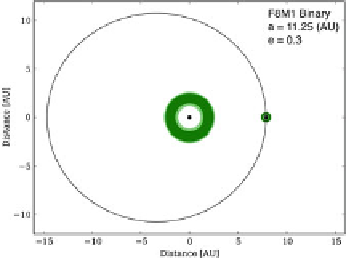Geoscience Reference
In-Depth Information
Fig. 13.15
Same as Fig.
13.14
, with the F star as the primary
component A of this system is a G2V star with a mass of 1:1M
Sun
, luminosity
of 1:519L
Sun
and an effective temperature of 5,790 K. Its component B has a
spectral type of K1V, and its mass, luminosity and effective temperature are equal
to 0:934M
Sun
, 0:5L
Sun
and 5,214 K, respectively.
The announcement of a probable super-Earth planet with a mass larger than 1.13
Earth masses around Ǜ Cen B (Dumusque et al.
2012
) indicates that unlike the
region around Ǜ Cen A where terrestrial planet formation encounters complications,
planet formation is efficient around this star (Guedes et al.
2008
; Thebault et al.
2009
) and it could also host a terrestrial planet in its HZ. Here we assume that
planet formation around both stars of this binary can proceed successfully, and they
both can host Earth-like planets. We calculate the spectral weight factors of both Ǜ
CenAandB(Table
13.2
) and, using the minimum and maximum added flux of the
secondary star, estimate the limits of their binary HZs using Eq. (
13.2
).
Tab le
13.3
shows the estimates of the boundaries of the binary HZ around
each star. The terms Max and Min in this table correspond to the planet-binary
configurations of .;/
D
.0;0/ and .0;180
ı
/ where the planet receives the
maximum and minimum total flux from the secondary star, respectively. As shown
here, each star of the Ǜ Centauri system contributes to increasing the limits of the
binary HZ around the other star. Although these contributions are small, they extend





























































































































































Search WWH ::

Custom Search